|
Designed
for 1024x768 by
archeophotography.com
Homepage
|
|
The
mystery of the ancient Megastoness
There is one mystery that ancient astronaut
theorists point out for many years. How did the ancients move stone
giants that weigh several hundred tons. While in the 1970s and 1980s
archaeologists didn't have an answer to this question, it seems that in
the last 20 years the conservative archaeologist fraction seems to have
more and more influence. They proclaim most of the mysteries are solved
or no mystery at all. But if we look more closely, some of the
archaeologists' theories are so far
fetched, the PaleoSeti Theory seems as rational
as 1+1=2.
Every year another theory comes up how stones were transported by the
ancients. Usually it’s a group of students between the ages of 15-25
that is carrying out the experiment. In those experiments, block of
(usually) concrete are dragged with the method the theory says, a few
meters from point A to point B. And usually the experiment is a
‘success’ and it is declared in some newspaper or TV show: “the mystery
is solved!”
But there are many problems with this ‘experimental archaeology’ and I
will illustrate with the example of Stonehenge, a popular subject for
experimental archaeology (In fact the mystery of Stonehenge has been
solved so many times in the past, that I’m wondering why they are still
looking):
1. We know the outcome. A solution to a problem is
much easier, if you know how the end result has to look like. We can
plan ahead as we have plenty of references over thousands of years of
construction and know what works and what doesn’t.
2. Our modern experiments require extensive
planning. The project leads are using pen and paper, do calculations
with computers, talk to engineers, carpenters, stone masons. But our
ancestors didn’t have pen and paper or computers. Or do we all over
sudden assume the ancient people had higher mathematics and script for
planning? Isn’t exactly that what modern archaeology says, the ancients
didn’t have?
3. Like I said before, the theories are usually
tested with a group of healthy, young and enthusiastic students. After
a day of hard studying they go home to mom and dad and a nice cooked
meal - that mom bought in the supermarket – is on the table. Or a nice
Microwave dish. Healthcare is provided – of course – and for every
boo-boo they go to the hospital, like we all do. During the experiment
you usually see an Ambulance parked in the background, just in case.
The experiment is conducted on a nice Saturday afternoon and if it’s
raining that day, it’s going to be postponed.
But the Ancients didn’t have all those luxuries. Healthy members of the
society (back then there was a life expectancy of 40-50) where needed
to provide food for their families. If an accident happened during
construction, no ambulance was there to help. If somebody got crushed
or badly injured by a stone, how did that reflect on the worker’s
enthusiasm? How is the motivation after a rainy day or a week of rain?
Clothes are soaked and the wind is blowing with 8 degrees Celsius. Do
that for weeks, months and years. Because that is what it takes to
transport the Bluestones of Stonehenge from their quarry in Wales to
where the stones are now. How does the food available in the Stone Age
affect a worker’s daily ability to work?
How many thousands of people are needed to provide the infrastructure
needed to accommodate, cloth and feed the workers? Or do we assume that
all several hundred men of the community just said to their families
“Guys we are going to a place far away to fetch some huge stones. We
will be back in a few years…”?
All of the above questions are not addressed during
those experiments. They are not even asked. That’s what makes those
experiments pure speculation at best.
Don't get me wrong I admire the ingenuity of
experimental archaeology and it has great value in other projects, like
daily life, dying colors, weaving textiles and similar tasks. But
transporting megastones? I have not seen any convincing explanation,
yet..
| Saqsayhuaman,
Peru |
|
|
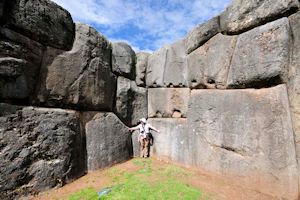
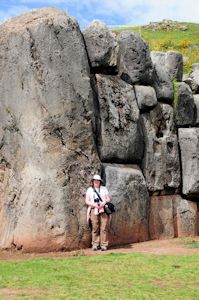
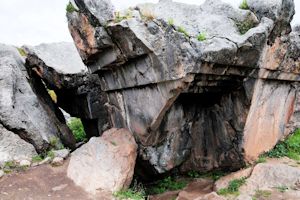
|
High above
the Peruvian City of Cusco is the ancient Inca fortress of Saqsayhuaman.
Over 600m long and built in three layers with gigantic stones
that are worked into each other with mind numbing precision, these
walls take a visitor's breath away. It is not only a mystery how the
stones were transported but how the ancient builders where able to fit
them together with such an accuracy, that not even a credit card could
fit in between the stones.
On the opposite side of the Fortress
lie gigantic rocks of a different nature. Mysterious and completely
inexplicable, they defy logic and reason if one doesn't consider the
ancient astronaut theory. |
| |
|
| Baalbek,
Lebanon |
|
|
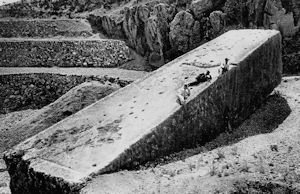

|
The ancient site of Baalbek in Lebanon features
some of the most giant stone structures on our planet. Some of the
stones used in this site are so enormous, they couldn't b lifted with
any modern crane today. Unfortunately I never visited the site before
because of the political situation during most of my lifetime, so I
can't show you my own photos. But the site and the stones of interest
to us did not change in the last 150 years, so I can show you historic
photos. That way I don't violate any copyright laws. Baalbek is one of
the sites on my "bucket list"....
...There are major problems with the notion that
the Romans are responsible for building the gigantic plattforms that
the temples of Baalbek rest on. There is no doubt, though, that the
UPPER structures are roman.
I'm only talking about the base stone plattforms.
1. The biggest problem is that there is no historical context that the
Romans ever used such gigantic stones. There are tens of thousands of
Roman sites all over Europe and not once did they use gigantic stones
like in Baalbek. Not even in Rome itself. It's this historical context
that archaeologists always want when they look at alternative theories
like Graham Hanckock's Lost Civilization Theory. And it was the main
point of the Egyptologists when they tried to make a case against
Geologist Robert Schoch when he found out that the Sphinx is much older
then currently accepted.
So the question "Where are similar Roman ruins with the same gigantic
blocks?" has to stay unanswered. There is usually a long silence in the
room when it is asked.
2. The gigantic plattforms are total "overkill" for the comparably
small temples on top. The Romans were smart cookies and knew exactly
what they were doing. They would have been stupid enough to go through
all the trouble of moving gigantic blocks like these, if they didn't
absolutely had to.
3. There is a comparable structure to Baalbek, that
not a lot of people know about. It's not that far away from Baalbek
either. And we know for certain, that it wasn't built by the Romans!
Read on...
|
| |
|
| Jerusalem,
Israel |
|
|
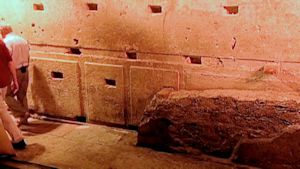
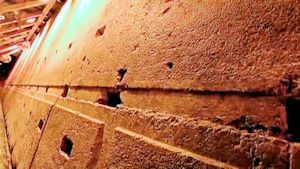
Images courtesy of
the Broadcast "The Naked Archaeologist", Copyright Vision
TV Canada
|
A
close cousin to the site of Baalbek (see above) is the temple mount in
Jerusalem. Not a lot of people are aware that the foundation of the old
temple was built with stones just as enormous as the ones from Baalbek. Stay
tuned for more info. |
| |
|
| Puma
Punku, Bolivia |
|
|
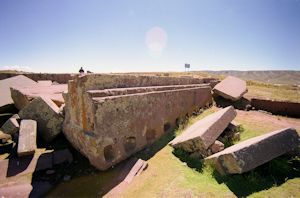
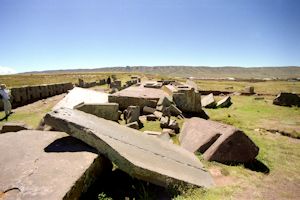
|
Im Puma
Punku in Bolivia, we can not only find very technical looking stone
carvings, but also gigantic megastones, like the ones in the photos to
the left. Six hundred tons is the weight of the big one in the top
photo. Nobody knows how they were transported there. |
| |
|
| Stonehenge,
England |
|
|
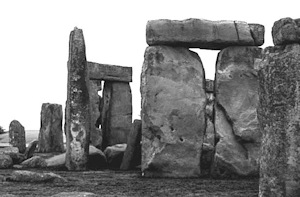
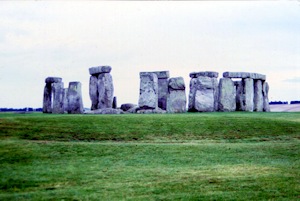
|
The
so
called "bluestones" of Stonehenge are enormous boulders, shaped and
erected in the Stone age around 2600 BC. The site contains different
sizes of stones, some of which are certainly manageable by working
groups in the Stone age. The problem with the big stones of Stonehenge
is that they come from a place that is roughly 250km away from the
site. This was always the 'big puzzler' for the construction of
stonehenge that Archaeologists just did not find a solution for. Pretty
much every explanation stopped with this problem. But instead of
looking into the PaleoSeti or lost Civilization Theories that offer
perfectly good explanantions to the problem, people try to really grasp
for straws. The newest Theory is now that glaciers pushed the stones
from the 250km distant quarry to the site (or at least close(r)). [1]
Now that's convenient! We can't fidure out how the ancients transported
stones because we do not want to look at the ancient astronaut theory
or admit that the ancients had more advanced tools, so we let nature do
the work for them!
The theory has so many holes, I don't even know where to start...
_______________________
[1]
Johnson, Anthony "Solving Stonehenge: The New Key to an Ancient
Enigma"; Thames and Hudson Publishing 2008; ISBN 978-0-500-05155-9
|
| |
|
|
|

